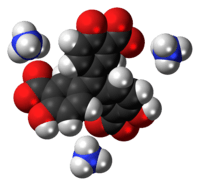Aluminon
 | |
 | |
| Names | |
|---|---|
| Other names
ammonium aurin-tricarboxylate; 5-[(3-carboxy-4-hydroxyphenyl)(3-carboxy-4-oxo-2,5-cyclohexadien-ylidene)methyl]-2-hydroxybenzoic acid triammonium salt | |
| Identifiers | |
| 569-58-4 | |
| 3D model (Jmol) | Interactive image |
| ChemSpider | 2016698 |
| ECHA InfoCard | 100.008.473 |
| PubChem | 2734958 |
| |
| |
| Properties | |
| C22H23N3O9 | |
| Molar mass | 473.43 g/mol |
| Appearance | yellow-brown crystals, red in aqueous solution |
| Solubility in other solvents | freely soluble in H2O |
| Except where otherwise noted, data are given for materials in their standard state (at 25 °C [77 °F], 100 kPa). | |
| | |
| Infobox references | |
Aluminon, the triammonium salt of aurintricarboxylic acid, is a dye commonly used to detect the presence of the aluminium ion in an aqueous solution. In addition to its use in qualitative inorganic analysis, aluminon has applications in pigment production. It forms brilliantly colored lake pigments with aluminum, chromium, iron, and beryllium.
Aluminon is prepared by reacting sodium nitrite with salicylic acid, adding formaldehyde, then treating with ammonia.[1]
See also
References
- ↑ Merck Index, 13th Ed.
This article is issued from Wikipedia - version of the 12/31/2015. The text is available under the Creative Commons Attribution/Share Alike but additional terms may apply for the media files.